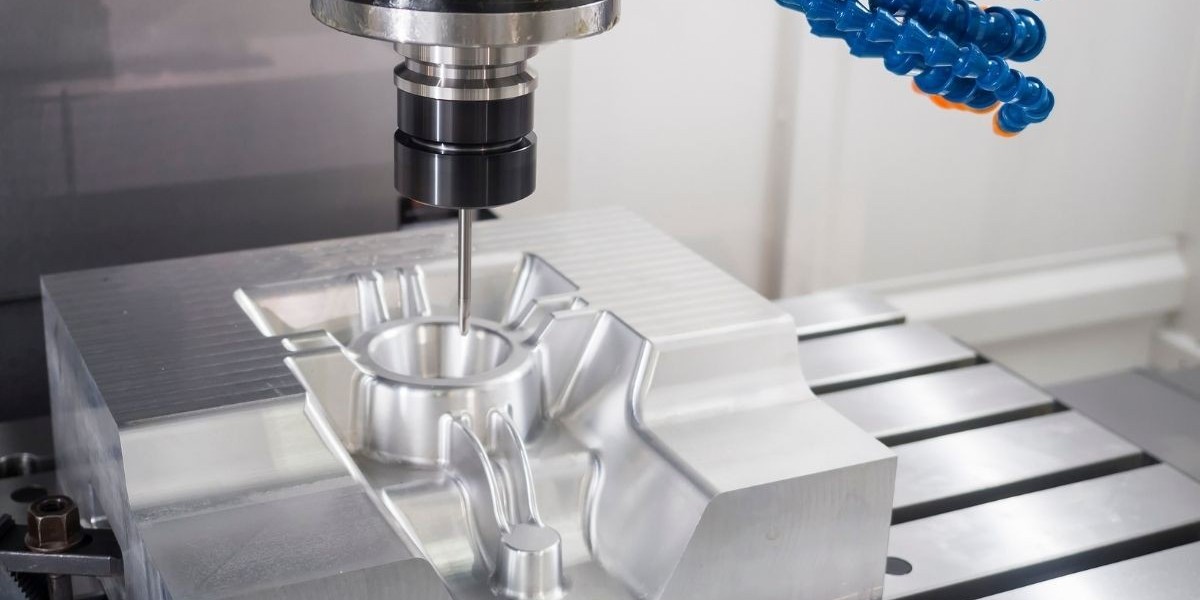Computer Numerical Control (CNC) machining has emerged as one of the most important innovations in modern manufacturing. With its ability to create complex and highly precise components, CNC machining is an essential technology for industries ranging from aerospace to automotive, medical, and electronics. The integration of computer technology with traditional machining methods has revolutionized how manufacturers approach production, offering improved efficiency, accuracy, and consistency.
This article explores the process of CNC machining, its various techniques, applications, advantages, and the future potential of this technology in the manufacturing landscape.
What is CNC Machining?
CNC machining refers to a process where computer software controls the movements of machinery to automate manufacturing tasks. These machines are used to shape materials, such as metals, plastics, or composites, into specific forms based on a digital design. Unlike conventional manual machining, CNC machines operate by following pre-programmed sequences of instructions (G-code or M-code) that precisely control tool movements.
The process begins with the design of the part using Computer-Aided Design (CAD) software. The design is then translated into machine-readable instructions using Computer-Aided Manufacturing (CAM) software. Once programmed, the CNC machine carries out the instructions with high accuracy, producing parts that are uniform and meet stringent specifications. CNC machining can handle tasks like cutting, drilling, milling, turning, and grinding.
Different Types of CNC Machining Processes
CNC machining encompasses several types of processes, each of which offers unique benefits depending on the application. These processes can work on various materials and are adaptable for both high-volume and low-volume production.
1. CNC Milling
CNC milling is one of the most common CNC machining processes. It involves rotating a cutting tool to remove material from a stationary workpiece. CNC mills can operate on multiple axes, allowing for intricate cuts and shapes. They are versatile machines capable of handling complex geometries, making them ideal for parts with detailed features.
Applications: Aerospace components, automotive parts, medical devices, and complex prototypes.
2. CNC Turning
CNC turning is a process in which the workpiece is rotated on a spindle while a cutting tool is moved along its surface to shape the material. This process is particularly effective for cylindrical or conical shapes and is commonly used for parts like shafts, pipes, and bushings.
Applications: Engine components, shafts, gears, and custom hardware in industries like automotive and medical.
3. CNC Drilling
CNC drilling uses a rotating tool to create precise holes in a workpiece. The process is ideal for producing holes of varying sizes and depths with great accuracy. CNC drilling is often combined with other processes to produce more detailed features, such as countersinks or chamfers.
Applications: Circuit boards, mechanical parts, structural components, and metal enclosures.
4. CNC Grinding
CNC grinding uses abrasive wheels to remove small amounts of material from a workpiece, achieving high-precision finishes. It is used for parts that require smooth surfaces, such as gears, shafts, and bearing races. CNC grinding can also be applied for cylindrical, surface, and centerless grinding operations.
Applications: Bearing surfaces, precision shafts, gears, and tools that require high tolerance.
5. CNC Electrical Discharge Machining (EDM)
Electrical Discharge Machining (EDM) is a non-traditional machining method that uses electrical sparks to remove material from a workpiece. This technique is particularly suited for machining hard materials or producing intricate shapes that are difficult to achieve with conventional tools. CNC EDM is essential in industries where fine details are critical.
Applications: Aerospace components, tool and die making, and intricate parts in industries like automotive and electronics.
6. CNC Laser Cutting
CNC laser cutting uses a focused laser beam to cut or etch materials with high precision. This method is especially effective for thin materials such as sheet metal, plastics, and wood. It produces smooth, accurate edges with minimal material waste.
Applications: Sheet metal fabrication, signage, automotive components, and custom parts.
Key Benefits of CNC Machining
The widespread adoption of CNC machining in various industries is driven by its numerous advantages. The following benefits highlight why this technology has become the standard for manufacturing:
1. High Precision and Consistency
CNC machines are known for their ability to create parts with high precision and repeatability. Once a program is established, the machine can execute the same movements with minimal variation, resulting in consistent and uniform parts. This level of precision is crucial for industries like aerospace, medical devices, and electronics, where even minor deviations can cause defects or failure.
2. Increased Efficiency and Automation
The automation of CNC machines leads to faster production times and fewer human interventions. Once the machine is programmed, it can run continuously, increasing production rates and reducing labor costs. The use of multiple-axis machines further enhances efficiency by allowing multiple operations to be performed on a part in a single setup.
3. Flexibility in Design and Material
CNC machining offers great flexibility in terms of the designs and materials that can be processed. With the use of CAD and CAM software, manufacturers can produce a wide range of shapes and intricate designs. Additionally, CNC machines can work with various materials, including metals, plastics, composites, and ceramics, making them versatile tools in diverse industries.
4. Reduced Waste and Cost-Effectiveness
CNC machining ensures precise cuts, reducing material waste and optimizing the use of raw materials. By minimizing scrap and reducing the need for secondary operations, manufacturers can lower production costs, especially when working with expensive materials like titanium or high-performance alloys.
5. Customization and Low-Volume Production
CNC machining is ideal for custom and low-volume production. It is easy to modify machine programs to accommodate design changes or create unique parts. As a result, manufacturers can produce prototype parts or limited-run products with the same efficiency and accuracy as mass-produced items.
6. Enhanced Safety
CNC machining enhances workplace safety by reducing the need for manual labor and direct interaction with cutting tools. Operators typically oversee the machine’s operation from a control panel, minimizing exposure to hazards associated with high-speed cutting equipment.
Industries That Benefit from CNC Machining
CNC machining is a versatile technology used across many industries, providing solutions for highly specialized and precision-driven applications. Some of the primary industries that benefit from CNC machining include:
1. Aerospace
The aerospace industry requires components that meet high safety and performance standards. CNC machining is essential in manufacturing lightweight and durable parts for aircraft, satellites, and propulsion systems. The technology’s precision allows for the creation of critical components such as turbine blades, engine housings, and landing gear.
2. Automotive
CNC machining is widely used in the automotive industry to produce parts like engine blocks, transmission components, gears, and exhaust systems. The ability to quickly prototype and produce complex parts with high precision is crucial for maintaining the efficiency and performance of modern vehicles.
3. Medical Devices
In the medical field, CNC machining plays a key role in producing components for surgical instruments, prosthetics, and implants. Parts used in medical devices must meet stringent regulatory standards, and the accuracy provided by CNC machines ensures that these components perform reliably in life-saving applications.
4. Electronics
CNC machining is indispensable in the electronics industry, where it is used to create parts for computer hardware, mobile devices, and other electronic devices. The precision capabilities of CNC machines are necessary for manufacturing components like connectors, housings, and custom enclosures for sensitive electronic components.
5. Energy and Oil & Gas
In the energy sector, CNC machining is employed to produce high-strength components for power generation, renewable energy systems, and oil & gas extraction equipment. CNC machines are used to fabricate turbine blades, valves, pumps, and drilling components that must withstand extreme pressures and harsh environments.
6. Defense and Military
CNC machining is crucial for the defense industry, where parts must meet high standards of durability and precision. From weaponry and vehicles to communication equipment and avionics, CNC machines produce parts that play a critical role in military operations.
The Future of CNC Machining
As technology continues to evolve, CNC machining is expected to become even more advanced, bringing about new possibilities in manufacturing. The future of CNC machining will likely include:
1. Integration of AI and Machine Learning
AI and machine learning technologies are set to further enhance the capabilities of CNC machines. With AI, machines will be able to analyze data from the production process, predict maintenance needs, and optimize operations in real-time, improving overall productivity.
2. Additive Manufacturing and Hybrid Machines
Hybrid machines that combine both additive (3D printing) and subtractive (CNC machining) technologies are gaining popularity. These machines allow manufacturers to create complex parts with both additive and traditional machining techniques, opening up new possibilities for design flexibility and material efficiency.
3. Smart Factories and IoT Integration
The integration of the Internet of Things (IoT) in CNC machining is expected to create smart factories where machines communicate and share data with one another. This interconnected environment will allow for real-time monitoring of machine performance, predictive maintenance, and optimized production schedules.
Conclusion
CNC machining has fundamentally transformed the manufacturing landscape, enabling industries to produce complex, high-precision parts with greater speed and consistency. Its flexibility, efficiency, and cost-effectiveness have made it an invaluable tool across a wide range of industries, from aerospace and automotive to medical and electronics. As technology continues to advance, CNC machining will remain a cornerstone of modern manufacturing, driving innovation and helping manufacturers meet the ever-evolving demands of the market.



